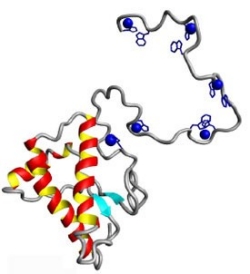Explaining Biological Phenomena Using Scientific Models
J. Am. Chem. Soc. 2007, 129, 15440

We collaborated with Bio 20A, an introductory biology course that covers a range of topics in cell and molecular biology. The course instructors noted that students often have difficulty in making sense of different models of biological systems or phenomena. Models are usually incomplete in what they represent (eg a ribbon structure that depicts protein secondary structure) but are useful for explaining something about that system at the expense of being a short-hand representation and other potential limitations. Being competent at understanding how to use models to explain biological phenomena was seen as an opportunity to strengthen students’ understanding of the content in the course, and a way to engage them in a core practice of science.
- Final rubric and assessment
Continue reading to learn more about this project and our process that can be used or adapted by other instructors with similar goals for their STEM course.
_____________________________
We aimed to develop a rubric that would provide a useful framework for assessment, student learning, and curricular design. Click the link above to learn more about how we developed the rubric. Our approach is summarized below.
- We conducted a literature search for existing frameworks on scientific models
- We identified specific components of using scientific models that we wanted 20A students to engage in. We tried to break down using models to explain biological phenomena into smaller components to facilitate feedback and design.
- Models are evaluated for their ability to represent and explain phenomena
- Phenomena can be represented by multiple models
- Models should be distinguished from the actual phenomena that it represents
- For each of the components, we defined a progression of understanding, asking, “what would different levels of engagement look like?”
- We considered how this rubric could be relevant for different biological systems in the course, including DNA replication models and protein structure and function.
_____________________________
Assessment Development Process
We developed an assessment that aligned with the goals articulated in the rubric above. The assessment needed to:
- Have enough information so that students would not be overwhelmed by understanding content
- Push students to explain or make a claim about the system under investigation
- Give students the opportunity to use multiple models to explain, not to tell us what they know about scientific models
In the link above, we highlight how we developed one assessment that was piloted in a 20A course. From the results of that pilot, we learned that we needed to go even further in asking students to explain and not to just tell us about the models. You can see our final assessment and revisions below.
_____________________________
Lessons Learned from Implementation in 20A
This section briefly summarizes the results of piloting this assessment and rubric with 49 students in a Bio20A course. These lessons learned have informed our revised rubric and would also inform future course design to engage students in scientific modeling.We would like to thank Melissa Jurica and Penny Carrol for their critical insights, experiences, and invaluable suggestions in the process of developing these tools and incorporating them into courses.
_____________________________
If you have questions or an interest in collaborating with ISEE to integrate modeling into your course, please contact us at isee@ucsc.edu.
